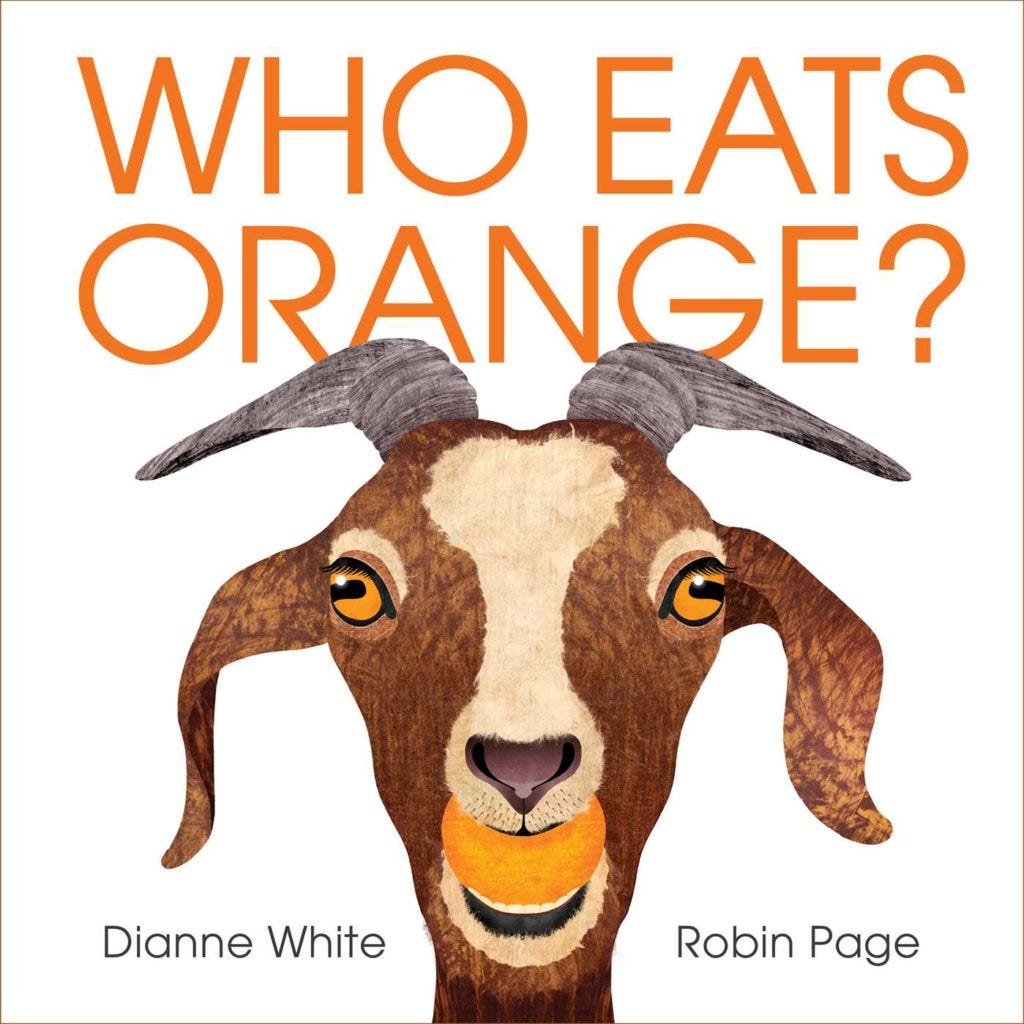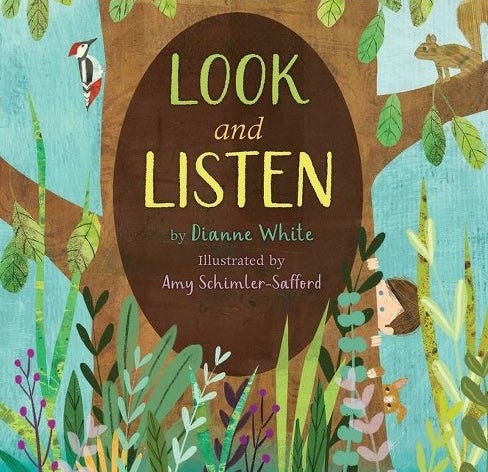One of the things I love most about Dianne White’s work is her attention to the small things that make life so lovely, especially when it comes to the natural world — I don’t think it’s an accident (if it is, it’s a poetic one) that her most recent book is titled Look and Listen. This is her gift, along with a rhythmic way with words that can make a lover out of even the most curmudgeonly anti-poetry person.
Yellow the flower.
Yellow the seed.
Yellow and black the buzzing bee.Lemonade petals.
Sunflakes between.
Lemonade, sunflakes, and yellow on green.
(Stanzas from the gorgeous Green on Green, illustrated by Felicita Sala, who I interviewed back in August)
There is something Emily Dickinsonian about White — a compression and tension that gives each word weight and renders even the simplest ones somehow beautiful. My children and I find her books to be particularly soothing and love reading them during our Morning Time, taking each page slowly to savor the language and images, which are always outstanding no matter the topic of the book or the illustrator.
I don’t know how a children’s author does this exactly, except by being incredibly talented and also great at being themselves. White’s style is immediately obvious once you’ve read two of her books — her relentless meter is as dependable as the tides, and somehow just as comforting.
Here’s her biography, from her website (which I tried to edit down and then decided to leave entirely because it’s such a rich example of the power of reading aloud and sharing poetry with children):
When I was growing up, I never thought I’d become a writer. My middle sister was the storyteller in our family and that was just fine with me. Except for my semi-famous-at-the-time “skunk in a bunk” poem, the only writing I did was for school and on that count, I managed to be perfectly average. In fact, for years I didn’t enjoy writing at all.
But you know what? Sometimes the things we come to enjoy best sneak up on us. Years later, we’re able to recognize who or what was responsible for initiating the tiny sparks of interest that grew into something bigger.
My 5th grade teacher, Mrs. Clark, was one such spark. Mrs. Clark was known for loving poetry. She recited poems to our class daily and the one thing she did that stuck in some tiny, important crevice of my heart was to make us memorize poems ourselves. To this day, I can’t read or hear John Masefield’s “Sea Fever” without picturing Mrs. Clark standing beside my desk reciting “I must go down to the seas again,” clearly loving each and every word.
In 6th grade, another spark was lit. Once a week, Mademoiselle Green, our French teacher, would drive over from the high school and teach us a new dialogue. I can still recite nearly every word of the first lesson, “Voilà Monsieur Thibaut. Voilà Madame Thibaut…”
What did French class have to do with becoming a writer? Well, for me, it was the beginning of a life-long love of foreign languages and a special appreciation for the sounds of words and the rhythms of speech. Just two years after that first foray into French, our family moved to the other side of the world where we were surrounded, once again, by new languages, sounds, and experiences. I graduated from junior high in the Philippines and high school in Hong Kong.
Jump ahead ten years, and all those rich experiences led to a college degree in French and Spanish. Ten years after that, I went back to school to earn a teaching credential.
As a classroom teacher, I rediscovered the joy of children’s poetry and books. I returned to some of the stories my grandmother had read to my sisters and me in childhood, as well as the mother goose poems we listened to incessantly the week we spent in our parents’ bed, all three of us sick with the mumps.
That love of teaching and language, poetry and children’s books led to more schooling — a master’s degree in Language and Literacy and an MFA in Writing for Children and Young Adults from Vermont College of Fine Arts.
Along the way, I married, raised three boys, and taught for 25 years with the most dedicated group of teachers I know.
Today, I’m lucky enough to write full-time. And on the days when I’m not at my desk, I’m probably taking a class (I’ll never stop being a student!), grabbing a bite with friends, or enjoying the sunshiny goodness of Arizona.
Without further ado, the wonderful Dianne White…
How long have you been writing and illustrating for children?
I came late to calling myself a writer and pretty much fell into it sometime after I began teaching. Between the books I read to my own kids and the new books I discovered as a teacher, I began to wonder if I might try to write the kinds of picture books I had grown to admire.
As I was completing the final semester of a Masters in Reading, my professor complimented my writing. Of course, the kind of technical writing I did to prepare for the comps was completely different from the fiction I was reading to kids, but it planted a small seed… Maybe I could be a writer.
That thought led me to begin looking for classes where I could learn from those who knew more. Soon, I discovered SCBWI — the Society of Children’s Book Writers Illustrators — and began a many years-long journey of learning, eventually selling my first book, Blue on Blue. One by one, more books followed.
What called you to this work?
I love that you frame the question this way because it does feel like a calling to me — a gift that dropped into my lap, something that became, unexplainably and surprisingly, a second career that I’m incredibly passionate about.
Writing books for kids is a big source of joy for me, the overlap of some of my most favorite things — books, words, and beautiful language. I’m truly grateful for the community of writers and friends I’ve met along the way.
Where do you get ideas for your books, and how do you stay inspired, title after title?
I like to tell kids that ideas are everywhere, in the ordinary, everyday things of life. Each story I’ve written — whether it has gone on to be published or not — started as a small spark, something I saw, heard, or experienced. Often, I can trace an idea directly back to a child.
Who Eats Orange? was something I heard a kindergartner say on a field trip to the pumpkin patch. The title of another book was the suggestion of a student who came up to me at the end of a school visit and said my next book should be called, Dark on Light. Of course, he was right! [It was published last week, on December 6.]
I’m a huge advocate for poetry for children. You write on your website about the impact a poetry-loving teacher had on you as a child, as well as how you rediscovered the joy of children's poetry and books as a classroom teacher yourself.
As an educator, author, and parent, why is poetry important for kids?
According to scientists, music literally shapes our brains, and poetry is a kind of music, don’t you think? It’s one of the reasons rhymes and songs and chants are so effective when teaching young kids.
It’s not just the music of poetry that can be enchanting but, also, its specificity and the way line breaks and images allow the poem to be a snapshot of something deeper, more emotional. A memory, a moment, a feeling. For emerging writers, the brevity of poetry can make it extremely appealing and accessible.
This is a question I ask everyone I interview: what are a few titles, recent or otherwise, that have stood out to you as being so excellent you wish they were on the shelf in every home and classroom?
Oh, my! This is a hard question because I do have so many favorites. Books cross borders and experiences, likes and dislikes, preferences and personalities, and help all of us develop empathy and understanding. Then, when something comes between us, we have the tools to look for “the me in you, and the you in me.”
Here are three recent books that I think can remind us that, for all our differences, we also have much in common:
Room For Everyone by Naaz Khan, illustrated by Mercè López
Milo Imagines the World by Matt de la Peña, illustrated by Christian Robinson
The Day You Begin by Jacqueline Woodson, illustrated by Rafael López
I can’t not include a collection of poetry so, of the many on my shelves, The 20th Century Children’s Poetry Treasury selected by Jack Prelutsky, illustrated by Meilo So, remains a favorite, no doubt, because this book sat on the chalk rail of my classroom long past the time when the chalkboard became a white board, and then a smart board. There are still bits of chalk dust on its pages. It has been well-loved! 😊
What’s next for you? Are you working on anything new you can tell us about?
I’m thrilled to say that I have a bunch of books coming out in the next few years. In 2022, it was Look and Listen, illustrated by Amy Schimler-Safford, and Dark on Light, illustrated by Felicita Sala. In 2023, The Sharing Book, illustrated by Simone Shin, and in 2024, finding grateful, illustrated by Faith Pray. There are more, but they haven’t been announced yet!
Rose the horizon, gleaming and bright
Twilight and evening and dark on light.
(A stanza from White’s most recently published book, Dark on Light, illustrated by Felicita Sala)
A huge thank you to White for taking the time to grant me this interview (and then waiting patiently for months — and months — as I arranged to publish it).
For more information about White’s work, visit her website. And be sure to seek out her books at your local library and bookstore (or order them online). They’re deeply lovely and well worth reading (and owning), every one.
Thanks for reading today, and always,
Sarah
P.S. Bookshop.org links in this post are affiliate ones — meaning I get a tiny commission if you use any of them to make a purchase. I appreciate your support!










What beautiful writing by this author. Thank you for the interview and for sharing her work. And you, my dear, have such lovely writing yourself. You have a real gift for writing about others’ writing.
Poetry for children - just perfect!